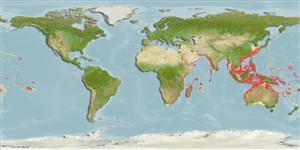>
Elopiformes (Tarpons and tenpounders) >
Megalopidae (Tarpons)
Etymology: Megalops: Greek, megas, megalos = great + Greek, ops = appearance (Ref. 45335).
Environment: milieu / climate zone / depth range / distribution range
Ecologia
marino; acqua dolce; salmastro benthopelagico; amfidromo; distribuzione batimetrica 1 - 50 m (Ref. 86942). Tropical; 34°N - 37°S, 16°E - 130°W
Indo-Pacific: Persian Gulf (Ref. 68964), Red Sea and Natal, South Africa (Ref. 3969) to the Society Islands, north to southern Korea, south to the Arafura Sea (Ref. 9819) and New South Wales. Restricted to high islands (Palau, Caroline and Mariana islands) in Micronesia. Reported as far inland as the lower Shire in Malawi and the Save-Runde junction in Zimbabwe (Ref. 7248, 52193). Widespread in the Lower Zambezi River channels up to Marromeu and in the Micelo River up to Malingapanzi (Ref. 39494). South China Sea, Taiwan Strait, and East China Sea(Ref.33302).
Length at first maturity / Size / Peso / Age
Maturity: Lm ?, range 25 - ? cm
Max length : 150 cm TL maschio/sesso non determinato; (Ref. 1479); common length : 30.0 cm SL maschio/sesso non determinato; (Ref. 7017); common length :45.5 cm SL (female); peso massimo pubblicato: 18.0 kg (Ref. 13337); Età massima riportata: 44 anni (Ref. 72487)
Spine dorsali (totale) : 0; Raggi dorsali molli (totale) : 16 - 21; Spine anali: 0; Raggi anali molli: 23 - 31.
Obligate air-breathing (Ref. 126274); Adults are generally found at sea, but young inhabit river mouths, inner bays, and mangrove forests. In freshwater, they occur in rivers, lagoons, lakes, and swampy backwaters (Ref. 2847, 44894). Tolerate a wide pH range (5.2-9.1) (Ref. 44894) and salinities from 0 to 100. Mainly diurnal (Ref. 7017). Predaceous, feeding mainly on fishes and crustaceans (Ref. 5213). Breed offshore, possibly throughout the year. Larvae are transparent and resemble larval eels (Ref. 13337), but with a forked tail (Ref. 167). Juveniles commonly enter freshwater (Ref. 44894, 48635) in clear or turbid water (Ref. 44894). Known to breath air, rising regularly to the surface to do so. Cultured in ponds, the fry being sourced from the coasts (Ref. 7050). Popular angling fish (Ref. 3969). Edible but not esteemed (Ref. 3969). Caught by gill nets, seines, and trawls, and by hook-and-line; marketed fresh and dried salted (Ref. 10982).
Whitehead, P.J.P., 1984. Megalopidae. In W. Fischer and G. Bianchi (eds.) FAO species identification sheets for fishery purposes. Western Indian Ocean fishing area 51. Vol. 3. [pag. var.]. FAO, Rome. (Ref. 3463)
IUCN Red List Status (Ref. 130435: Version 2024-1)
Threat to humans
Harmless
Human uses
Pesca: scarso interesse commerciale; Acquacoltura: commerciale; Pesce da pesca sportiva: si
Strumenti
Special reports
Download XML
Fonti Internet
Estimates based on models
Preferred temperature (Ref.
123201): 19.8 - 27.6, mean 24.4 °C (based on 501 cells).
Phylogenetic diversity index (Ref.
82804): PD
50 = 1.0020 [Uniqueness, from 0.5 = low to 2.0 = high].
Bayesian length-weight: a=0.00741 (0.00528 - 0.01040), b=3.07 (2.97 - 3.17), in cm total length, based on LWR estimates for this species (Ref.
93245).
Trophic level (Ref.
69278): 3.5 ±0.1 se; based on diet studies.
Resilienza (Ref.
120179): Medio, tempo minimo di raddoppiamento della popolazione 1.4 - 4.4 anni (Assuming tm<=4).
Prior r = 0.57, 95% CL = 0.37 - 0.85, Based on 2 data-limited stock assessments.
Fishing Vulnerability (Ref.
59153): Very high vulnerability (90 of 100).
Climate Vulnerability (Ref.
125649): High to very high vulnerability (75 of 100).
Nutrients (Ref.
124155): Calcium = 44.8 [26.3, 77.6] mg/100g; Iron = 0.672 [0.410, 1.048] mg/100g; Protein = 17.1 [14.3, 19.7] %; Omega3 = 0.217 [0.122, 0.396] g/100g; Selenium = 71.1 [41.2, 135.1] μg/100g; VitaminA = 15 [6, 33] μg/100g; Zinc = 1.06 [0.78, 1.46] mg/100g (wet weight);
